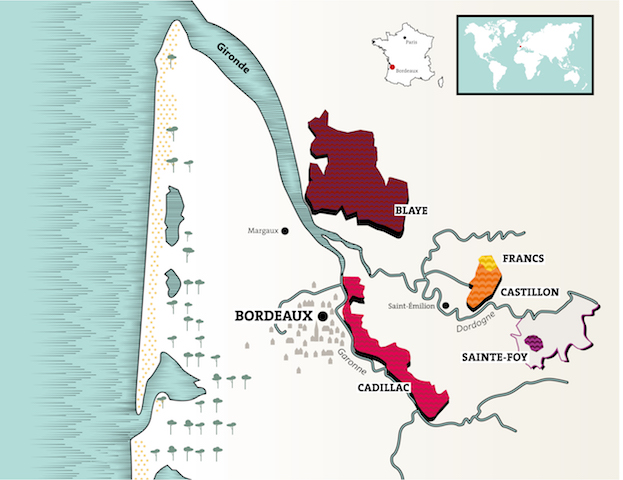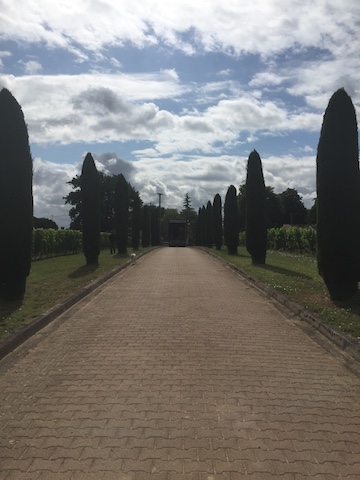Posted: Jul 15, 2018

By Andrew Chalk Senior Contributing Editor
Everybody loves the wines of Bordeaux. Everybody also says that "they are just too expensive". So they, including sommeliers and beverage managers, search elsewhere, usually ending up with something that is only distantly similar. This compromise is actually unnecessary. Bordeaux is a region, not a single area, and it encompasses over 50 different designated wine growing areas known as AOPs (Appellation d'Origine Protégée). The much discussed expensive Bordeaux is actually a reference to a handful of globally prized AOP wines: The wines from the villages on the left bank of the Gironde river just north of town that were classified in 1855. The similar wines from Graves and Pessac-Leognon close to town. Sauternes, the world’s most famous sweet white wine. And the areas on the right bank of the Dordogne river, Saint-Émilion and Pomerol.

That leaves about four fifths of the AOPs unaccounted for. In the past, ignoring them may not have meant a large opportunity lost, but with the prices of the majors having increased multiple times the rate of inflation for over 30 years and the quality of the other AOPs having improved steadily, now is the time to revisit that decision. The result will be a richer wine list with prices that are more customer friendly and margins that are more rewarding. Most of the wines that I discuss here are less than €15 ($18) retail in Europe, implying U.S. retail less than $30 after shipping and other costs. Yet they challenge the quality of the established AOPs.
The Côtes de Bordeaux is a group of five Bordeaux AOPs who have joined together to jointly market themselves to the world. They are Blaye, Cadillac, Castillon, Francs, and Sainte-Foy. To assist the consumer they use conjunctive labelling (so, for example, Blaye is labelled as Blaye - Côtes de Bordeaux). Producers can also just use the Côtes de Bordeaux AOP. A practice followed by some, for example Château Haut-Rian in Cadillac. On the map of the Bordeaux region the AOPs are dispersed widely. The difference in terroir shows in the wines.

Blaye - Côtes de Bordeaux: North of the city of Bordeaux on the opposite bank of the Gironde facing the famous Médoc region, this appellation of 6,500 hectares (ha)/16,250 acres (ac) produces virtually entirely red wine. The most planted red grapes are Merlot 70%, Cabernet Sauvignon 20% and Malbec 10%. The average size of estates is 15 ha (37.5 acres) and there are 430 winegrowers.
Terroir: Clay-limestone, clay-gravel, and clay-silica. Maritime climate influence means high humidity and high sunlight.
Cadillac - Côtes de Bordeaux: The Gironde splits into the Dordogne and the Garonne just north of the city of Bordeaux. If you follow the Garonne fork Cadillac is on the right bank, opposite the city, although it extends much further south. It is 2,200 ha/5,500 ac. Estates average 11 ha/27.5 ac and 100% of the plantings are red. Merlot 55%, Cabernet Sauvignon 25%, Cabernet Franc 15%, and Malbec 5%.
Terroir: Limestone covered with pebbly gravel at the peaks, clay-limestone mid-slope, and fine gravel mixed with silica at the foot of the slopes. High sunshine.
Castillon - Côtes de Bordeaux: East of the city of Bordeaux, on the right bank of the Dordogne fork of the Gironde. Castillon is adjacent to Saint-Émilion to its west and the popular vacation area, the Dordogne, to its east.There are 2300 ha/5,750 ac planted with vines. It is all red grapes in the AOP. Merlot 70%, Cabernet Franc 20%, and Cabernet Sauvignon 10%.
Terroir: Modern alluvium in the north. Sandy gravel or sandy clay which turns into clay limestone or marlstone on the hillsides. Climate mild and humid. Partly maritime, partly continental.
Francs - Côtes de Bordeaux: The appendix at the top of Castillon. Francs is only 435 ha/ 1087.5 ac, with estates averaging 10 ha. Red varieties are: Merlot 60%, Cabernet Sauvignon 25%, Cabernet Franc 15%. Whites: Sémillon 60%, Sauvignon Blanc 32%, Muscadelle 8%.
Terroir: Subsoil of fossil rich limestone covered with limestone molasse called molasse d’Agenais. Dry continental climate. Hills protect from from hail.
Sainte-Foy - Côtes de Bordeaux: Only 350 ha/875 ac in an island to the east of all of the other AOPs in the Côtes de Bordeaux. With only 21 winegrowers estates average 9 ha/22.5 ac. This is the Côtes de Bordeaux source of sweet white wines. Red grapes: Merlot 65%, Cabernet Sauvignon 17%, Cabernet Franc 15%, and Malbec 3%. Whites: Sauvignon Blanc 60%, Sémillon 30%, Muscadelle 10%.
Terroir: Clay-limestone soil. Temperate climate with continental influence.
On a recent visit to the appellation sponsored by the Union des Côtes de Bordeaux I came away with several lasting impressions.
First, the rationale for buying the globally established AOP wines cited above for reasons of quality have, in most cases disappeared. Take a blind tasting of wines of Saint-Emilion and Castillon - Côtes de Bordeaux. Both areas are Merlot-dense with a healthy minority representation of Cabernet Franc. They are physically adjacent. Hence the styles are similar. Some time ago the Saint-Emilion wines would have stood out as superior Now, only a few at the very top would be distinguishable. This broad parity is still unrecognized in the wider market so the price of Castillon - Côtes de Bordeaux is much less than the price of Saint-Emilion wine. Land prices are lower too so smart money from Saint-Emilion is investing in Castillon - Côtes de Bordeaux. In other words, they get it.
Second. Sainte-Foy - Côtes de Bordeaux, the smallest and newest member of the Côtes de Bordeaux (it only joined in 2016) may have the biggest throw-weight of all the constituent AOPs. It not only brings sweet white wines to the table, it also makes dry whites with oak ageing that complexifies the flavors and adds body to the mouthfeel. Try, for example, the wines of Château Hostens-Picant.
By Andrew Chalk
July 15, 2018
Go-Wine's mission is to organize food and beverage information and make it universally accessible and beneficial. These are the benefits of sharing your article in Go-Wine.com


The Wine Thief Bistro & Specialty Wines is a locally owned small business in downtown Frankfort, IL offering world class wines in a relaxed, casual gathering spot for friends and family. Offering world class virtual tastings and touchless carryout.
https://www.twtwineclub.com/aboutus
Go-Wine 25 Great Wineries in US selection prioritizes quality, value and availability.
www.go-wine.com/great-wineries-in-america
Tasting wine is a nice experience, but visiting the places in which wine is made is a magic moment. Available in New York City for touchless pickup.